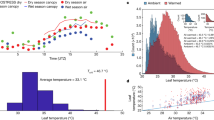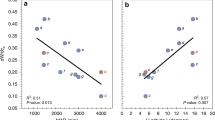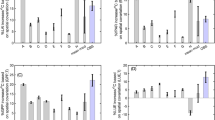Abstract
Tropical forests may be vulnerable to climate change1,2,3 if photosynthetic carbon uptake currently operates near a high temperature limit4,5,6. Predicting tropical forest function requires understanding the relative contributions of two mechanisms of high-temperature photosynthetic declines: stomatal limitation (H1), an indirect response due to temperature-associated changes in atmospheric vapour pressure deficit (VPD)7, and biochemical restrictions (H2), a direct temperature response8,9. Their relative control predicts different outcomes—H1 is expected to diminish with stomatal responses to future co-occurring elevated atmospheric [CO2], whereas H2 portends declining photosynthesis with increasing temperatures. Distinguishing the two mechanisms at high temperatures is therefore critical, but difficult because VPD is highly correlated with temperature in natural settings. We used a forest mesocosm to quantify the sensitivity of tropical gross ecosystem productivity (GEP) to future temperature regimes while constraining VPD by controlling humidity. We then analytically decoupled temperature and VPD effects under current climate with flux-tower-derived GEP trends in situ from four tropical forest sites. Both approaches showed consistent, negative sensitivity of GEP to VPD but little direct response to temperature. Importantly, in the mesocosm at low VPD, GEP persisted up to 38 °C, a temperature exceeding projections for tropical forests in 2100 (ref. 10). If elevated [CO2] mitigates VPD-induced stomatal limitation through enhanced water-use efficiency as hypothesized9,11, tropical forest photosynthesis may have a margin of resilience to future warming.
This is a preview of subscription content, access via your institution
Access options
Access Nature and 54 other Nature Portfolio journals
Get Nature+, our best-value online-access subscription
$29.99 / 30 days
cancel any time
Subscribe to this journal
Receive 12 digital issues and online access to articles
$119.00 per year
only $9.92 per issue
Buy this article
- Purchase on Springer Link
- Instant access to full article PDF
Prices may be subject to local taxes which are calculated during checkout




Similar content being viewed by others
Data availability
The datasets analysed in this study (eddy flux and environmental data) are available at https://daac.ornl.gov/cgi-bin/dsviewer.pl?ds_id=1174 (for K34 and K83) and https://ameriflux.lbl.gov/sites/siteinfo/BR-Sa1 (for K67). The datasets for Tesopaco and the B2-TF are available at https://github.com/m-n-smith/B2-temp-paper-datasets.
Code availability
The R code used to conduct the analyses presented in this paper is available upon request from the corresponding authors.
References
Galbraith, D. et al. Multiple mechanisms of Amazonian forest biomass losses in three dynamic global vegetation models under climate change. N. Phytol. 187, 647–665 (2010).
Brienen, R. J. W. et al. Long-term decline of the Amazon carbon sink. Nature 519, 344–348 (2015).
Longo, M. et al. Ecosystem heterogeneity and diversity mitigate Amazon forest resilience to frequent extreme droughts. N. Phytol. 219, 914–931 (2018).
Doughty, C. E. & Goulden, M. L. Are tropical forests near a high temperature threshold? J. Geophys. Res. Biogeosci. 113, G00B07 (2008).
Mau, A., Reed, S., Wood, T. & Cavaleri, M. Temperate and tropical forest canopies are already functioning beyond their thermal thresholds for photosynthesis. Forests 9, 47 (2018).
Huang, M. et al. Air temperature optima of vegetation productivity across global biomes. Nat. Ecol. Evol. 3, 772–779 (2019).
Grossiord, C. et al. Plant responses to rising vapor pressure deficit. N. Phytol. 226, 1550–1566 (2020).
Sharkey, T. D. Effects of moderate heat stress on photosynthesis: importance of thylakoid reactions, Rubisco deactivation, reactive oxygen species, and thermotolerance provided by isoprene. Plant Cell Environ. 28, 269–277 (2005).
Lloyd, J. & Farquhar, G. D. Effects of rising temperatures and [CO2] on the physiology of tropical forest trees. Phil. Trans. R. Soc. B 363, 1811–1817 (2008).
IPCC Climate Change 2013: The Physical Science Basis (eds Stocker, T. F. et al.) (Cambridge Univ. Press, 2013).
Dusenge, M. E., Duarte, A. G. & Way, D. A. Plant carbon metabolism and climate change: elevated CO2 and temperature impacts on photosynthesis, photorespiration and respiration. N. Phytol. 221, 32–49 (2019).
Janzen, D. H. Why mountain passes are higher in the tropics. Am. Nat. 101, 233–249 (1967).
Cunningham, S. C. & Read, J. Do temperate rainforest trees have a greater ability to acclimate to changing temperatures than tropical rainforest trees? N. Phytol. 157, 55–64 (2003).
Sullivan, M. J. P. et al. Long-term thermal sensitivity of Earth’s tropical forests. Science 368, 869–874 (2020).
Lancaster, L. T. & Humphreys, A. M. Global variation in the thermal tolerances of plants. Proc. Natl Acad. Sci. USA 117, 13580–13587 (2020).
Mora, C. et al. The projected timing of climate departure from recent variability. Nature 502, 183–187 (2013).
Hutyra, L. R. et al. Seasonal controls on the exchange of carbon and water in an Amazonian rain forest. J. Geophys. Res. Biogeosci. 112, G03008 (2007).
Slot, M. & Winter, K. In situ temperature relationships of biochemical and stomatal controls of photosynthesis in four lowland tropical tree species. Plant Cell Environ. 40, 3055–3068 (2017).
Tcherkez, G. et al. Leaf day respiration: low CO2 flux but high significance for metabolism and carbon balance. N. Phytol. 216, 986–1001 (2017).
O’Sullivan, O. S. et al. Thermal limits of leaf metabolism across biomes. Glob. Change Biol. 23, 209–223 (2017).
Leakey, A. D. B. et al. Elevated CO2 effects on plant carbon, nitrogen, and water relations: six important lessons from FACE. J. Exp. Bot. 60, 2859–2876 (2009).
Keenan, T. F. et al. Increase in forest water-use efficiency as atmospheric carbon dioxide concentrations rise. Nature 499, 324–327 (2013).
Fredeen, A. L. & Sage, R. F. Temperature and humidity effects on branchlet gas-exchange in white spruce: an explanation for the increase in transpiration with branchlet temperature. Trees 14, 161–168 (1999).
Barron-Gafford, G. A., Grieve, K. A. & Murthy, R. Leaf- and stand-level responses of a forested mesocosm to independent manipulations of temperature and vapor pressure deficit. N. Phytol. 174, 614–625 (2007).
Vargas, G. G. & Cordero, S. R. A. Photosynthetic responses to temperature of two tropical rainforest tree species from Costa Rica. Trees 27, 1261–1270 (2013).
Slot, M., Garcia, M. N. & Winter, K. Temperature response of CO2 exchange in three tropical tree species. Funct. Plant Biol. 43, 468–478 (2016).
Slot, M. & Winter, K. in Tropical Tree Physiology: Adaptations and Responses in a Changing Environment (eds Goldstein, G. & Santiago, L. S.) 385–412 (Springer International, 2016).
Santos, V. A. H. Fdos et al. Causes of reduced leaf-level photosynthesis during strong El Niño drought in a Central Amazon forest. Glob. Change Biol. 24, 4266–4279 (2018).
Wu, J. et al. Partitioning controls on Amazon forest photosynthesis between environmental and biotic factors at hourly to interannual timescales. Glob. Change Biol. 23, 1240–1257 (2017).
Tan, Z.-H. et al. Optimum air temperature for tropical forest photosynthesis: mechanisms involved and implications for climate warming. Environ. Res. Lett. 12, 054022 (2017).
Slot, M. & Winter, K. In situ temperature response of photosynthesis of 42 tree and liana species in the canopy of two Panamanian lowland tropical forests with contrasting rainfall regimes. N. Phytol. 214, 1103–1117 (2017).
Arain, M. A., Shuttleworth, W. J., Farnsworth, B., Adams, J. & Sen, O. L. Comparing micrometeorology of rain forests in Biosphere-2 and Amazon basin. Agric. Meteorol. 100, 273–289 (2000).
Cavaleri, M. A., Reed, S. C., Smith, W. K. & Wood, T. E. Urgent need for warming experiments in tropical forests. Glob. Change Biol. 21, 2111–2121 (2015).
Taub, D. R., Seemann, J. R. & Coleman, J. S. Growth in elevated CO2 protects photosynthesis against high‐temperature damage. Plant Cell Environ. 23, 649–656 (2000).
Doughty, C. E. An in situ leaf and branch warming experiment in the Amazon. Biotropica 43, 658–665 (2011).
Taylor, T. C. et al. Isoprene emission structures tropical tree biogeography and community assembly responses to climate. N. Phytol. 220, 435–446 (2018).
Taylor, T. C., Smith, M. N., Slot, M. & Feeley, K. J. The capacity to emit isoprene differentiates the photosynthetic temperature responses of tropical plant species. Plant Cell Environ. 42, 2448–2457 (2019).
Rowland, L. et al. Modelling climate change responses in tropical forests: similar productivity estimates across five models, but different mechanisms and responses. Geosci. Model Dev. 8, 1097–1110 (2015).
Tan, Z.-H. et al. Interannual and seasonal variability of water use efficiency in a tropical rainforest: results from a 9 year eddy flux time series. J. Geophys. Res. D 120, 464–479 (2015).
Gray, S. B. et al. Intensifying drought eliminates the expected benefits of elevated carbon dioxide for soybean. Nat. Plants 2, 16132 (2016).
Leigh, L. S., Burgess, T., Marino, B. D. V. & Wei, Y. D. Tropical rainforest biome of Biosphere 2: structure, composition and results of the first 2 years of operation. Ecol. Eng. 13, 65–93 (1999).
Lin, G. et al. An experimental and modeling study of responses in ecosystems carbon exchanges to increasing CO2 concentrations using a tropical rainforest mesocosm. Funct. Plant Biol. 25, 547–556 (1998).
Lin, G. et al. Ecosystem carbon exchange in two terrestrial ecosystem mesocosms under changing atmospheric CO2 concentrations. Oecologia 119, 97–108 (1999).
Rascher, U. et al. Functional diversity of photosynthesis during drought in a model tropical rainforest—the contributions of leaf area, photosynthetic electron transport and stomatal conductance to reduction in net ecosystem carbon exchange. Plant Cell Environ. 27, 1239–1256 (2004).
Silver, W. L. et al. Effects of soil texture on belowground carbon and nutrient storage in a lowland Amazonian forest ecosystem. Ecosystems 3, 193–209 (2000).
Davidson, E. A., Nepstad, D. C., Ishida, F. Y. & Brando, P. M. Effects of an experimental drought and recovery on soil emissions of carbon dioxide, methane, nitrous oxide, and nitric oxide in a moist tropical forest. Glob. Change Biol. 14, 2582–2590 (2008).
Restrepo-Coupe, N. et al. What drives the seasonality of photosynthesis across the Amazon basin? A cross-site analysis of eddy flux tower measurements from the Brasil flux network. Agric. Meteorol. 182–183, 128–144 (2013).
Araújo, A. C. et al. Comparative measurements of carbon dioxide fluxes from two nearby towers in a central Amazonian rainforest: the Manaus LBA site. J. Geophys. Res. 107, 8090 (2002).
Gonçalves, L. Gde et al. Overview of the large-scale biosphere–atmosphere experiment in Amazonia Data Model Intercomparison Project (LBA-DMIP). Agric. Meteorol. 182–183, 111–127 (2013).
Perez-Ruiz, E. R. et al. Carbon dioxide and water vapour exchange in a tropical dry forest as influenced by the North American Monsoon System (NAMS). J. Arid Environ. 74, 556–563 (2010).
Álvarez-Yépiz, J. C., Martínez-Yrízar, A., Búrquez, A. & Lindquist, C. Variation in vegetation structure and soil properties related to land use history of old-growth and secondary tropical dry forests in northwestern Mexico. For. Ecol. Manage. 256, 355–366 (2008).
Rosolem, R., Shuttleworth, W. J., Zeng, X., Saleska, S. R. & Huxman, T. E. Land surface modeling inside the Biosphere 2 tropical rain forest biome. J. Geophys. Res. 115, G4 (2010).
Muir, C. D. tealeaves: an R package for modelling leaf temperature using energy budgets. AoB Plants 11, plz054 (2019).
Hayek, M. N. et al. A novel correction for biases in forest eddy covariance carbon balance. Agric. Meteorol. 250, 90–101 (2018).
Chambers, J. Q. et al. Respiration from a tropical forest ecosystem: partitioning of sources and low carbon use efficiency. Ecol. Appl. 14, 72–88 (2004).
Saleska, S. R. et al. Carbon in Amazon forests: unexpected seasonal fluxes and disturbance-induced losses. Science 302, 1554–1557 (2003).
Goulden, M. L. et al. Diel and seasonal patterns of tropical forest CO2 exchange. Ecol. Appl. 14, 42–54 (2004).
Acknowledgements
We thank E. A. Yepez and J. Garatuza-Payan for providing the Tesopaco eddy flux data and J. Berry for the leaf-level chlorophyll fluorescence measurements, collected at B2 in collaboration with J.A. We thank M. Strangstalien, B. Enquist and A. Swann for useful comments on the manuscript. This work was supported by the National Science Foundation’s (NSF) Partnerships for International Research and Education (PIRE) (no. OISE-0730305) and the Philecological Foundation, with additional support from the US Department of Energy (DOE) (GOAmazon award no. 3002937712), the National Aeronautics and Space Administration (NASA) (LBA-DMIP project, award no. NNX09AL52G) and the University of Arizona’s Agnese Nelms Haury Program in Environment and Social Justice. M.N.S. and J.W. were supported by the NASA Earth and Space Science Fellowship (NESSF) program (grant no. NNX14AK95H). In addition, J.W. was partly supported by the DOE’s next-generation ecosystem experiments project in the tropics (NGEE-Tropics) at Brookhaven National Laboratory. T.C.T. was supported by the NSF Division of Biological Infrastructure with grant no. NSF‐PRFB‐1711997. The meteorological data collection and quality control analysis of the B2-TF dataset by R.R. were also supported by the NESSF program (grant no. NNX09AO33H) and the UK National Environment Research Council (NERC, grant nos NE/M003086/1 and NE/R004897/1).
Author information
Authors and Affiliations
Contributions
M.N.S., T.C.T., S.R.S. and T.E.H. conceived the study, designed the analyses and led the data interpretation, with extensive help from J.v.H. and R.R. M.N.S. performed the data analysis and drafted the manuscript, with substantial input from T.C.T., S.R.S. and T.E.H. R.R. provided the carbon exchange data for the B2-TF and advice on its analysis. N.R.-C., R.C.d.O., R.d.S., A.C.d.A., P.B.d.C. and S.R.S. contributed to the installation, maintenance or analysis of the eddy flux data from the LBA tower sites. J.W. provided advice on the binned regression analysis. J.A. collected and analysed the leaf-level chlorophyll fluorescence measurements in the B2-TF. All authors contributed to writing the final manuscript.
Corresponding authors
Ethics declarations
Competing interests
The authors declare no competing interests.
Additional information
Peer review information Nature Plants thanks Molly Cavaleri and the other, anonymous, reviewer(s) for their contribution to the peer review of this work.
Publisher’s note Springer Nature remains neutral with regard to jurisdictional claims in published maps and institutional affiliations.
Supplementary information
Supplementary Information
Supplementary Notes 1–3, Figs. 1–6 and references.
Rights and permissions
About this article
Cite this article
Smith, M.N., Taylor, T.C., van Haren, J. et al. Empirical evidence for resilience of tropical forest photosynthesis in a warmer world. Nat. Plants 6, 1225–1230 (2020). https://doi.org/10.1038/s41477-020-00780-2
Received:
Accepted:
Published:
Issue Date:
DOI: https://doi.org/10.1038/s41477-020-00780-2
This article is cited by
-
Critical transitions in the Amazon forest system
Nature (2024)
-
Tropical forests are approaching critical temperature thresholds
Nature (2023)
-
Recent decrease of the impact of tropical temperature on the carbon cycle linked to increased precipitation
Nature Communications (2023)
-
Evidence and attribution of the enhanced land carbon sink
Nature Reviews Earth & Environment (2023)
-
Forest fragmentation impacts the seasonality of Amazonian evergreen canopies
Nature Communications (2022)



